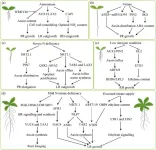(Press-News.org) A team of scientists at UNSW has discovered that some of the most important new refrigerants break down, in part, into persistent greenhouse gas pollutants, including compounds that have been banned internationally. Refrigerants are chemicals that turn from a liquid to a gas – and vice-versa – and transfer heat in the process, that are used for refrigeration and indoor heating and cooling. The chemicals are also used as aerosol propellants, fire retardants and in the manufacture of foamed plastics.
Hydrofluoroolefins (HFOs), which react rapidly in the lower atmosphere, have emerged as the lead synthetic chemical for refrigerants, and are considered a more environmentally friendly alternative to their chemical predecessors.
While it’s known that HFOs decompose into chemicals like trifluoroacetaldehyde, there has been persistent discussion about whether this compound further breaks down into fluoroform – the most environmentally damaging hydrofluorocarbon (HFC) they were used to replace.
A paper led by Dr Christopher Hansen from UNSW Chemistry, and published in the Journal of the American Chemical Society, has demonstrated that HFOs do break down into a small amount of fluoroform. This new research suggests we need to more closely examine HFOs’ environmental impact, raising questions about their long-term safety.
“We don’t fully understand the environmental impacts of HFOs at this point,” says Dr Hansen. “But, unlike previous examples such as the CFCs and leaded petrol, we are trying to figure out the consequences of large-scale emission before we’ve potentially harmed the environment and human health in an irreversible way. We're trying to try to change the way that science introduces new products.”
The story so far
The hole in the ozone layer is a result of human activities that have released ozone-depleting chemicals, including chlorofluorocarbons (CFCs) – some of the first synthetic chemicals used as refrigerants and in aerosol cans.
Thanks to The Montreal Protocol, society began phasing these out internationally, and they were largely replaced with HFCs, which were used on a global scale from the mid 90s.
Although HFCs don't cause any ozone layer depletion, they turned out to be potent greenhouse gases. “In the end, scientists discovered that 1kg of fluoroform – a once commonly used HFC – emitted today will contribute to as much to surface heating of the planet over the next century as more than 14,000kg of carbon dioxide,” says Dr Hansen.
After realising the extreme greenhouse warming potential of HFCs, their global phaseout began in 2016.
HFOs, which have a shorter atmospheric lifetime, are now the leading synthetic replacements and are being rapidly proliferated as refrigerants, foam-blowing agents – such as those used in insulating foam – and aerosol propellants.
While scientists know some information about the chemical pathways of HFO decomposition, there has been a longstanding debate about whether they actually break down into some of the most environmentally unfriendly HFCs.
Experiments simulating the atmosphere
HFOs are made up of chemical units that are more reactive than their previous counterparts, so they don’t rise to the upper atmosphere and become long-lived greenhouse gases.
“But as chemists, we look at the structures of these molecules and we start to try and imagine what they are turned into,” says Dr Hansen. “So rather than just go, oh, this thing only has a lifetime of two weeks, it can't be a greenhouse gas, we must see what it's turned into.
“And most chemists will look at these structures, and they can draw reactions that actually lead to HFCs.”
But confirming whether HFOs break down into HFCs in low yields requires difficult experiments and most existing techniques and instruments lack the sensitivity and specificity to do so.
Dr Hansen and his team used multiple techniques, including two invented just for this study, to measure and evaluate the chemical reaction across the full range of pressures expected in the atmosphere.
“We used a variety of spectroscopic techniques to observe the reaction. And we made up a gas mixture at various pressures to simulate an atmosphere polluted with a trace amount of the immediate HFO decomposition product. Then we used a laser to simulate the photons that would otherwise come from the sun, to drive the reaction,” says Dr Hansen.
New data for climate models
We know that HFOs decompose into fluorinated carbonyls such as trifluoroacetaldehyde at a yield up to, or greater than, 100%. This means all the molecules of HFO turn into the first product and, for some HFOs, you might get two molecules of that product for each molecule of HFO that breaks down. This study reveals that the next step of the reaction, driven by light, produces a small amount of fluoroform from the decomposition of trifluoroacetaldehyde. Fluoroform is the HFC with the greatest global warming potential.
“We have demonstrated comprehensively that some of the most important HFOs do break down into HFCs and have provided the first hard scientific data needed to model and predict the consequences of large-scale emission,” says Dr Hansen. “Although the reaction only produces a small amount of fluoroform, the chemical can exist in the atmosphere for up to 200 years, and with a global warming potential more than 14000 times greater than CO2, a small yield can still have a significant impact.”
Many atmospheric crises have caught us by surprise. “Think leaded petrol, lethal smog events of the 20th century, the ozone hole crisis,” Dr Hansen explains. “But this wasn’t because our models were not good enough, but rather because the important chemistry was missing from the models,” he says.
Now, this study settles a longstanding controversy and provides the hard, scientific data needed to model and predict the impact of large-scale emission of HFOs, before policymakers may need to react to an emerging environmental crisis.
Climate modelling groups at UNSW, as well as scientists around the world, are now ready to input this data into models, to help work out the environmental impact of continuing to use HFOs.
“Although questions remain, this paper offers crucial evidence that should inform the next steps in addressing the environmental impact of the chemicals we release into the atmosphere,” Dr Hansen says.
Dr Hansen and his team are planning further novel experimental work. “For this paper, we performed the experiments at a single wavelength, the wavelength used in studies that are presently guiding regulators, industry, governments,” he says. “We plan to study this chemistry using other wavelengths of light, where the yield could be higher or lower.”
END
Are our refrigerants safe? The lingering questions about the chemicals keeping us cool
2025-02-27
ELSE PRESS RELEASES FROM THIS DATE:
How nitrogen reshapes root system architecture in plants?
2025-02-27
In soil, nitrogen (N), an essential macronutrient for plant growth, exhibits significant spatial heterogeneity. This necessitates plants to grapple with a complex array of environmental conditions in their quest for N sustenance. Roots, as the pivotal organs in N acquisition, manifest a remarkable morphological plasticity, including variations in the length and density of primary roots, lateral roots, and root hairs, in response to the form and content of available N, which is termed N-dependent root system architecture (RSA). For cultivated crops, the ...
‘Fluorescent phoenix’ discovered with persistence rivaling Marie Curie’s
2025-02-27
A research team at POSTECH (Pohang University of Science and Technology) has successfully developed a super-photostable organic dye after two years of dedicated research—demonstrating perseverance akin to that of Marie Curie, who painstakingly extracted just 0.1 grams of radium from eight tons of ore to earn her Nobel Prize.
Single-molecule imaging, a technique that uses fluorescent markers to track proteins with precision, plays a crucial role in cell biology, biochemistry, molecular biology, and drug discovery. However, conventional organic ...
A rapid and reproducible method for generating germ-free Drosophila melanogaster
2025-02-27
Benefits of the New Method:
Enhanced Efficiency: The filter membrane allows air exchange while preventing bacterial contamination, eliminating the need for frequent cap opening and reducing the risk of errors.
Improved Reproducibility: The standardized protocol ensures consistent results, with a 100% success rate in generating germ-free flies compared to the previous 70%–80% rate.
Streamlined Process: This method simplifies the entire process, making it more accessible to researchers and allowing for larger-scale experiments.
Implications for Research:
This advancement opens doors for deeper exploration of the intricate dance between hosts ...
Aging and the brain’s sugar-coated shield
2025-02-27
What if a critical piece of the puzzle of brain aging has been hiding in plain sight? While neuroscience has long focused on proteins and DNA, a team of Stanford researchers dared to shift their gaze to sugars – specifically the complex sugar chains that cover all our cells like chain mail.
Their investigation revealed how changes in this sugary armor on the brain’s frontline cells could be key to understanding cognitive decline and diseases like Alzheimer’s.
“This is like landing on a new planet,” ...
Better poverty mapping: New machine-learning approach targets aid more effectively
2025-02-27
ITHACA, N.Y. – Leveraging national surveys, big data, and machine learning, Cornell University researchers have developed a new approach to mapping poverty that could help policymakers and NGOs better identify the neediest populations in poor countries and allocate resources more effectively.
To eliminate extreme poverty, defined as surviving on less than $2.15 per person per day, governments and development and humanitarian agencies need to know how many people live under that threshold, and where. Yet that information ...
An emissions tale of two cities: Salt Lake City vs. Los Angeles
2025-02-27
They may both be Olympic host cities, but Salt Lake City and Los Angeles, the major population hubs of their respective states, are much different places. However, they both experience poor air quality and share valley topography that traps pollutants during weather inversions.
Utah and Southern California differ sharply in their approaches to this problem, with the latter implementing more stringent regulations and fuel standards aimed at reducing emissions from motor vehicles. New research from the University ...
WVU nursing faculty aim to enhance rural home care for chronically ill through NIH award
2025-02-27
Three West Virginia University nursing faculty know firsthand the difficulties faced by family caregivers and their chronically ill loved ones.
With a $2.7 million award from the National Institutes of Health’s National Institute of Nursing Research that is one of the largest ever for the WVU School of Nursing, the faculty researchers aim to support these families while increasing access to care in the rural reaches of the Mountain State by testing an integrated, nurse-led intervention for family home care management of end-stage heart failure and palliative care.
“We want to know if there’s a way we can help relieve the suffering for these individuals ...
New screening tool for stroke survivors with visual perception problems
2025-02-27
A new 15-minute tool to screen stroke survivors for visual perception problems has been launched by researchers from Durham and Oxford universities.
The free screening tool could make it easier for health professionals to identify difficulties in patients after a stroke and meet the need for an assessment that is quick and simple to administer.
The research behind the screening tool, funded by the National Institute for Health and Care Research (NIHR) and the Stroke Association, is published in Clinical Rehabilitation today.
Up to 76 per cent of stroke ...
Influencer marketing can help tourism industry mitigate waste, pollution
2025-02-26
UNIVERSITY PARK, Pa. — Social media influencers who are passionate about environmental causes can help the tourism industry inspire tourists to engage in pro-environmental behavior to help mitigate waste and pollution, according to a new study from researchers in the Penn State School of Hospitality Management.
The research team found that influencers who are highly passionate about sustainability lifestyles — coined “green influencers” — can increase tourists’ environmental support through social media messaging. The researchers also found that environmental support, or backing waste reduction and wildlife conservation efforts, ...
Tufts named a top producer of U.S. Fulbright students
2025-02-26
Tufts University has been recognized again as one of the colleges and universities with the highest number of students selected for the Fulbright U.S. Student Program. During the 2024-2025 academic year, 13 students from Tufts were selected for Fulbright awards and are currently studying and researching across the globe.
Tufts has received this honor several times in recent years, including most recently in 2023-2024 and 2021-2022.
The U.S. government’s flagship international academic exchange program, the Fulbright U.S. Student program offers a year-long grant for students, scholars, teachers, artists, and professionals ...






